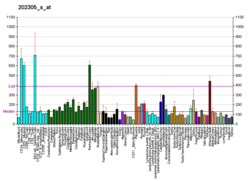Protein-coding gene in the species Homo sapiens
| FEZ2 |
|---|
|
| Identifiers |
|---|
| Aliases | FEZ2, HUM3CL, fasciculation and elongation protein zeta 2 |
|---|
| External IDs | OMIM: 604826; MGI: 2675856; HomoloGene: 3742; GeneCards: FEZ2; OMA:FEZ2 - orthologs |
|---|
| Gene location (Human) |
|---|
 | | Chr. | Chromosome 2 (human)[1] |
|---|
| | Band | 2p22.2 | Start | 36,531,805 bp[1] |
|---|
| End | 36,646,087 bp[1] |
|---|
|
| Gene location (Mouse) |
|---|
 | | Chr. | Chromosome 17 (mouse)[2] |
|---|
| | Band | 17 E2- E3|17 48.57 cM | Start | 78,676,641 bp[2] |
|---|
| End | 78,725,581 bp[2] |
|---|
|
| RNA expression pattern |
|---|
| Bgee | | Human | Mouse (ortholog) |
|---|
| Top expressed in | - endothelial cell
- secondary oocyte
- Skeletal muscle tissue of rectus abdominis
- Skeletal muscle tissue of biceps brachii
- thoracic diaphragm
- deltoid muscle
- parietal pleura
- muscle of thigh
- visceral pleura
- Brodmann area 23
|
| | Top expressed in | - epithelium of lens
- sternocleidomastoid muscle
- muscle of thigh
- triceps brachii muscle
- retinal pigment epithelium
- right ventricle
- temporal muscle
- quadriceps femoris muscle
- digastric muscle
- gastrocnemius muscle
|
| | More reference expression data |
|
|---|
| BioGPS | 
 | | More reference expression data |
|
|---|
|
| Gene ontology |
|---|
| Molecular function | | | Cellular component | | | Biological process | - signal transduction
- nervous system development
- negative regulation of autophagosome assembly
- axon guidance
| | Sources:Amigo / QuickGO |
|
| Orthologs |
|---|
| Species | Human | Mouse |
|---|
| Entrez | | |
|---|
| Ensembl | | |
|---|
| UniProt | | |
|---|
| RefSeq (mRNA) | | |
|---|
NM_001285940
NM_001285946
NM_001285949
NM_199448
NM_001360407 |
|
|---|
| RefSeq (protein) | | |
|---|
NP_001272869
NP_001272875
NP_001272878
NP_955519
NP_001347336 |
|
|---|
| Location (UCSC) | Chr 2: 36.53 – 36.65 Mb | Chr 17: 78.68 – 78.73 Mb |
|---|
| PubMed search | [3] | [4] |
|---|
|
| Wikidata |
| View/Edit Human | View/Edit Mouse |
|
Fasciculation and elongation protein zeta-2 is a protein that in humans is encoded by the FEZ2 gene.[5][6]
This gene is an ortholog of the C. elegans unc-76 gene, which is necessary for normal axonal bundling and elongation within axon bundles. Other orthologs include the rat gene that encodes zygin II, which can bind to synaptotagmin.[6]
Interactions
FEZ2 has been shown to interact with Protein kinase Mζ.[7]
References
- ^ a b c GRCh38: Ensembl release 89: ENSG00000171055 – Ensembl, May 2017
- ^ a b c GRCm38: Ensembl release 89: ENSMUSG00000056121 – Ensembl, May 2017
- ^ "Human PubMed Reference:". National Center for Biotechnology Information, U.S. National Library of Medicine.
- ^ "Mouse PubMed Reference:". National Center for Biotechnology Information, U.S. National Library of Medicine.
- ^ Bloom L, Horvitz HR (May 1997). "The Caenorhabditis elegans gene unc-76 and its human homologs define a new gene family involved in axonal outgrowth and fasciculation". Proc Natl Acad Sci U S A. 94 (7): 3414–9. Bibcode:1997PNAS...94.3414B. doi:10.1073/pnas.94.7.3414. PMC 20384. PMID 9096408.
- ^ a b "Entrez Gene: FEZ2 fasciculation and elongation protein zeta 2 (zygin II)".
- ^ Fujita, Toshitsugu; Ikuta Junko; Hamada Juri; Okajima Toshihide; Tatematsu Kenji; Tanizawa Katsuyuki; Kuroda Shun'ichi (Jan 2004). "Identification of a tissue-non-specific homologue of axonal fasciculation and elongation protein zeta-1". Biochem. Biophys. Res. Commun. 313 (3). United States: 738–44. doi:10.1016/j.bbrc.2003.12.006. ISSN 0006-291X. PMID 14697253.
Further reading
- Ranes-Goldberg MG, Hori T, Mohan-Peterson S, Spits H (1993). "Identification of human pre-T/NK cell-associated genes". J. Immunol. 151 (10): 5810–21. doi:10.4049/jimmunol.151.10.5810. PMID 8228263. S2CID 39286195.
- Kolle G, Georgas K, Holmes GP, et al. (2000). "CRIM1, a novel gene encoding a cysteine-rich repeat protein, is developmentally regulated and implicated in vertebrate CNS development and organogenesis". Mech. Dev. 90 (2): 181–93. doi:10.1016/S0925-4773(99)00248-8. PMID 10642437. S2CID 6529349.
- Hu RM, Han ZG, Song HD, et al. (2000). "Gene expression profiling in the human hypothalamus-pituitary-adrenal axis and full-length cDNA cloning". Proc. Natl. Acad. Sci. U.S.A. 97 (17): 9543–8. Bibcode:2000PNAS...97.9543H. doi:10.1073/pnas.160270997. PMC 16901. PMID 10931946.
- Strausberg RL, Feingold EA, Grouse LH, et al. (2003). "Generation and initial analysis of more than 15,000 full-length human and mouse cDNA sequences". Proc. Natl. Acad. Sci. U.S.A. 99 (26): 16899–903. Bibcode:2002PNAS...9916899M. doi:10.1073/pnas.242603899. PMC 139241. PMID 12477932.
- Surpili MJ, Delben TM, Kobarg J (2004). "Identification of proteins that interact with the central coiled-coil region of the human protein kinase NEK1". Biochemistry. 42 (51): 15369–76. doi:10.1021/bi034575v. PMID 14690447.
- Fujita T, Ikuta J, Hamada J, et al. (2004). "Identification of a tissue-non-specific homologue of axonal fasciculation and elongation protein zeta-1". Biochem. Biophys. Res. Commun. 313 (3): 738–44. doi:10.1016/j.bbrc.2003.12.006. PMID 14697253.
- Hillier LW, Graves TA, Fulton RS, et al. (2005). "Generation and annotation of the DNA sequences of human chromosomes 2 and 4". Nature. 434 (7034): 724–31. Bibcode:2005Natur.434..724H. doi:10.1038/nature03466. PMID 15815621.
- Assmann EM, Alborghetti MR, Camargo ME, Kobarg J (2006). "FEZ1 dimerization and interaction with transcription regulatory proteins involves its coiled-coil region". J. Biol. Chem. 281 (15): 9869–81. doi:10.1074/jbc.M513280200. PMID 16484223.


















